中国的环境污染【英文】
2019年以中国的环境污染为话题的初中英语作文
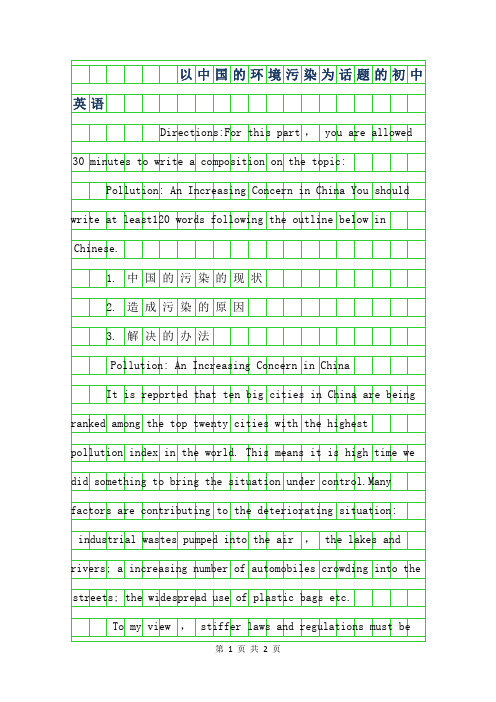
1. 中国的污染的现状
2. 造成污染的原因
3.பைடு நூலகம்解决的办法
Pollution: An Increasing Concern in China
It is reported that ten big cities in China are being ranked among the top twenty cities with the highest pollution index in the world. This means it is high time we did something to bring the situation under control.Many factors are contributing to the deteriorating situation: industrial wastes pumped into the air, the lakes and rivers; a increasing number of automobiles crowding into the streets; the widespread use of plastic bags etc.
环境污染用英语怎么说
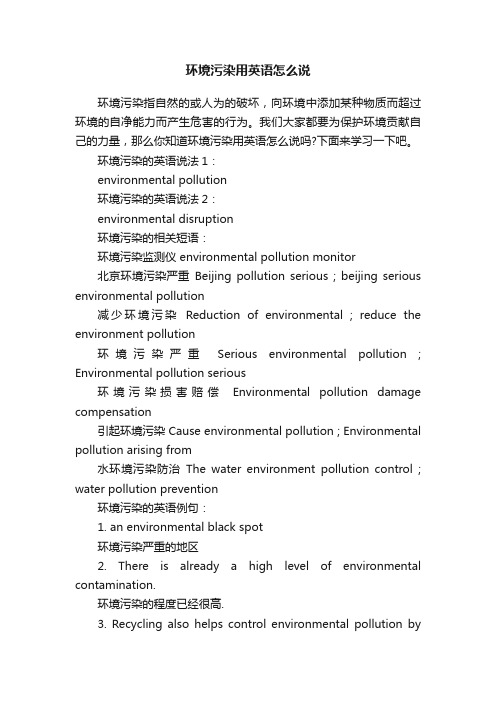
环境污染用英语怎么说环境污染指自然的或人为的破坏,向环境中添加某种物质而超过环境的自净能力而产生危害的行为。
我们大家都要为保护环境贡献自己的力量,那么你知道环境污染用英语怎么说吗?下面来学习一下吧。
环境污染的英语说法1:environmental pollution环境污染的英语说法2:environmental disruption环境污染的相关短语:环境污染监测仪 environmental pollution monitor北京环境污染严重Beijing pollution serious ; beijing serious environmental pollution减少环境污染Reduction of environmental ; reduce the environment pollution环境污染严重Serious environmental pollution ; Environmental pollution serious环境污染损害赔偿Environmental pollution damage compensation引起环境污染 Cause environmental pollution ; Environmental pollution arising from水环境污染防治The water environment pollution control ; water pollution prevention环境污染的英语例句:1. an environmental black spot环境污染严重的地区2. There is already a high level of environmental contamination.环境污染的程度已经很高.3. Recycling also helps control environmental pollution byreducing the need for waste dumps.对废弃物的回收利用能够减少对垃圾场的需求,从而也有助于控制环境污染。
中国最严重环境问题英语作文
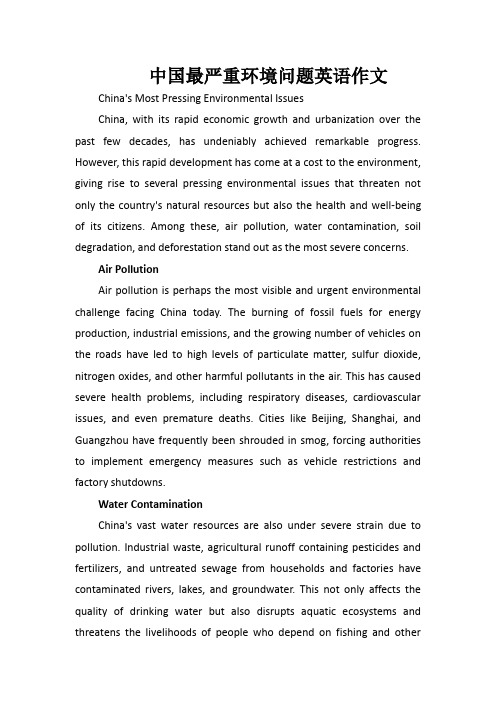
中国最严重环境问题英语作文China's Most Pressing Environmental IssuesChina, with its rapid economic growth and urbanization over the past few decades, has undeniably achieved remarkable progress. However, this rapid development has come at a cost to the environment, giving rise to several pressing environmental issues that threaten not only the country's natural resources but also the health and well-being of its citizens. Among these, air pollution, water contamination, soil degradation, and deforestation stand out as the most severe concerns.Air PollutionAir pollution is perhaps the most visible and urgent environmental challenge facing China today. The burning of fossil fuels for energy production, industrial emissions, and the growing number of vehicles on the roads have led to high levels of particulate matter, sulfur dioxide, nitrogen oxides, and other harmful pollutants in the air. This has caused severe health problems, including respiratory diseases, cardiovascular issues, and even premature deaths. Cities like Beijing, Shanghai, and Guangzhou have frequently been shrouded in smog, forcing authorities to implement emergency measures such as vehicle restrictions and factory shutdowns.Water ContaminationChina's vast water resources are also under severe strain due to pollution. Industrial waste, agricultural runoff containing pesticides and fertilizers, and untreated sewage from households and factories have contaminated rivers, lakes, and groundwater. This not only affects the quality of drinking water but also disrupts aquatic ecosystems and threatens the livelihoods of people who depend on fishing and otherwater-related activities. The problem is particularly acute in regions with high population densities and intense industrial activities.Soil DegradationSoil degradation, caused by overexploitation, erosion, and pollution, is another major environmental concern in China. Intensive farming practices, including the overuse of chemical fertilizers and pesticides, have depleted soil nutrients and harmed soil structure. This has led to decreased crop yields and increased vulnerability to natural disasters like droughts and floods. Moreover, soil pollution from industrial waste and mining activities poses a long-term threat to food safety and human health.DeforestationDeforestation, driven by timber harvesting, agricultural expansion, and urbanization, has significantly reduced China's forest cover. Forests are vital for maintaining ecological balance, regulating climate, and providing habitats for wildlife. Their loss has contributed to soil erosion, reduced water quality, and loss of biodiversity. Additionally, deforestation exacerbates the problem of air pollution by reducing the capacity of trees to absorb carbon dioxide and other greenhouse gases.Addressing the ChallengesRecognizing the severity of these environmental issues, the Chinese government has taken steps to address them. Policies aimed at reducing air pollution, improving water quality, restoring degraded soil, and protecting forests have been implemented. These include stricter environmental regulations, investments in clean energy technologies, and public awareness campaigns. However, much more needs to be done, and it will require the concerted efforts of the government,businesses, and individuals to ensure a sustainable future for China and its people.In conclusion, China faces significant environmental challenges that require immediate and sustained action. By addressing issues such as air pollution, water contamination, soil degradation, and deforestation, China can not only protect its natural resources but also ensure a healthier and more prosperous future for its citizens.。
中国现在最严重的环境问题英语作文开头
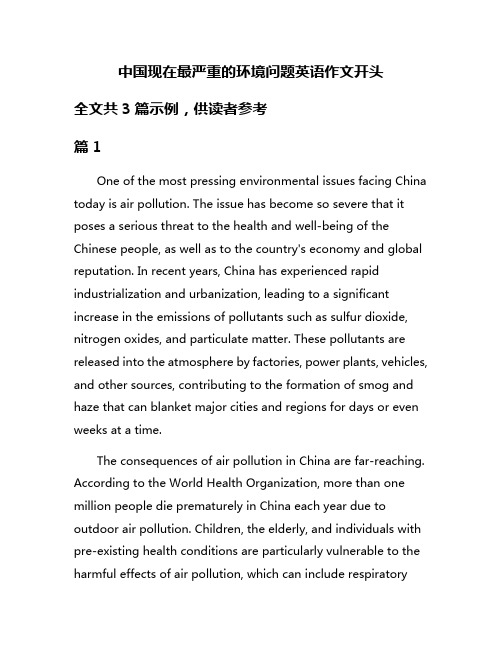
中国现在最严重的环境问题英语作文开头全文共3篇示例,供读者参考篇1One of the most pressing environmental issues facing China today is air pollution. The issue has become so severe that it poses a serious threat to the health and well-being of the Chinese people, as well as to the country's economy and global reputation. In recent years, China has experienced rapid industrialization and urbanization, leading to a significant increase in the emissions of pollutants such as sulfur dioxide, nitrogen oxides, and particulate matter. These pollutants are released into the atmosphere by factories, power plants, vehicles, and other sources, contributing to the formation of smog and haze that can blanket major cities and regions for days or even weeks at a time.The consequences of air pollution in China are far-reaching. According to the World Health Organization, more than one million people die prematurely in China each year due to outdoor air pollution. Children, the elderly, and individuals with pre-existing health conditions are particularly vulnerable to the harmful effects of air pollution, which can include respiratorydiseases, heart problems, and even cancer. In addition to its health impacts, air pollution also has economic costs, as it can reduce labor productivity, increase healthcare expenses, and damage crops and ecosystems.Despite the severity of the problem, efforts to address air pollution in China have been met with mixed results. The Chinese government has implemented a number of policies and initiatives aimed at reducing emissions and improving air quality, such as setting targets for pollution control, promoting cleaner technologies, and establishing emission standards for vehicles and industries. However, enforcement of these measures has been inconsistent, and many regions continue to struggle with high levels of pollution. In addition, China's reliance on coal for energy production remains a major obstacle to reducing air pollution, as coal combustion is a leading source of pollutants and greenhouse gases.In order to effectively tackle the issue of air pollution in China, a comprehensive and coordinated approach is needed. This includes strengthening regulations and enforcement mechanisms, investing in cleaner technologies and renewable energy sources, promoting public awareness and participation, and collaborating with international partners to addresstransboundary pollution issues. By taking decisive action to improve air quality, China can protect the health of its citizens, safeguard its natural environment, and demonstrate its commitment to sustainable development on the global stage.篇2One of the most pressing environmental issues facing China today is air pollution. With the rapid industrialization and urbanization of the country, the level of air pollution has soared to dangerous levels, posing serious health risks to the population and causing harm to the environment.The main source of air pollution in China is the burning of fossil fuels for energy production, transportation, and heating. This releases a high amount of pollutants such as particulate matter, sulfur dioxide, nitrogen oxides, and volatile organic compounds into the air, leading to the formation of smog and haze that blankets many cities in China.The health impacts of air pollution are significant, with studies linking it to respiratory diseases, cardiovascular diseases, and even premature death. Children, the elderly, and individuals with pre-existing health conditions are particularly vulnerable to the effects of air pollution.In addition to the health risks, air pollution also has detrimental effects on the environment. It contributes to acid rain, which damages forests, freshwater ecosystems, and buildings. It also accelerates the process of climate change by increasing the concentration of greenhouse gases in the atmosphere.To address the issue of air pollution, the Chinese government has introduced various measures such as setting air quality standards, implementing emission control policies, and promoting renewable energy sources. However, more efforts are needed to curb the worsening air pollution problem in China and protect the health of its citizens and the environment.篇3One of the most serious environmental issues in China today is air pollution. With the rapid industrialization and urbanization that the country has undergone in recent decades, the levels of pollutants in the air have reached dangerously high levels. The effects of air pollution are widespread and far-reaching, posing a serious threat to both public health and the environment.In major cities like Beijing, Shanghai, and Guangzhou, the air quality often exceeds safe levels, leading to a range of healthproblems such as respiratory diseases, cardiovascular diseases, and even premature death. The smog that blankets these cities is not only unsightly, but also contains a toxic mix of pollutants that can have serious health consequences for the people living there.One of the primary sources of air pollution in China is the burning of coal for energy production. Coal-fired power plants and industrial facilities release large amounts of sulfur dioxide, nitrogen oxides, and particulate matter into the air, contributing to the formation of harmful smog. In addition, the widespread use of cars and trucks also adds to the problem, as vehicles emit pollutants such as nitrogen oxides and volatile organic compounds.The Chinese government has recognized the severity of the air pollution problem and has taken steps to address it. In recent years, stricter regulations have been put in place to limit the emissions of pollutants from industrial sources and vehicles. The government has also invested in renewable energy sources such as wind and solar power in an effort to reduce reliance on coal.Despite these efforts, air pollution remains a major challenge for China. In order to effectively tackle this issue, a comprehensive approach is needed that addresses not only thesources of pollution, but also factors such as urban planning, transportation, and waste management. By taking bold and decisive action, China can work towards cleaner air for all its citizens and a healthier environment for future generations.。
中国污染日益严重英语作文
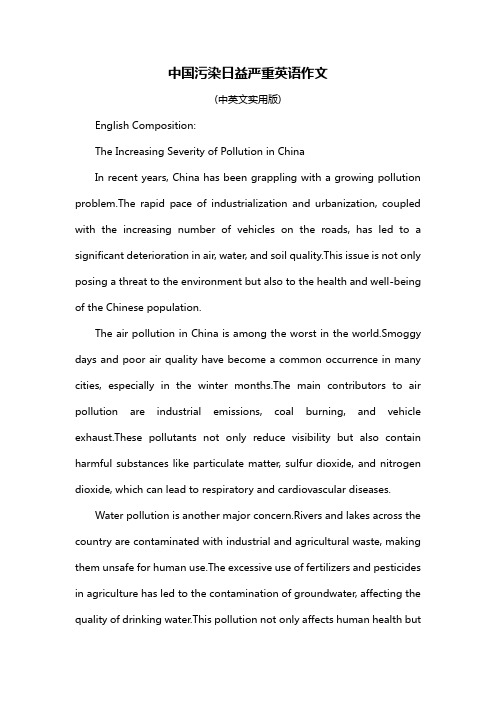
中国污染日益严重英语作文(中英文实用版)English Composition:The Increasing Severity of Pollution in ChinaIn recent years, China has been grappling with a growing pollution problem.The rapid pace of industrialization and urbanization, coupled with the increasing number of vehicles on the roads, has led to a significant deterioration in air, water, and soil quality.This issue is not only posing a threat to the environment but also to the health and well-being of the Chinese population.The air pollution in China is among the worst in the world.Smoggy days and poor air quality have become a common occurrence in many cities, especially in the winter months.The main contributors to air pollution are industrial emissions, coal burning, and vehicle exhaust.These pollutants not only reduce visibility but also contain harmful substances like particulate matter, sulfur dioxide, and nitrogen dioxide, which can lead to respiratory and cardiovascular diseases.Water pollution is another major concern.Rivers and lakes across the country are contaminated with industrial and agricultural waste, making them unsafe for human use.The excessive use of fertilizers and pesticides in agriculture has led to the contamination of groundwater, affecting the quality of drinking water.This pollution not only affects human health butalso disrupts aquatic ecosystems and biodiversity.Soil pollution is equally alarming, with industrial waste and heavy metals contaminating the soil.This poses a serious threat to food safety, as these pollutants can enter the food chain through crops grown in contaminated soil.The long-term exposure to polluted soil can also lead to various health issues in humans.The Chinese government is aware of the severity of the pollution problem and has taken several measures to address it.Strict regulations have been implemented to control industrial emissions, and there has been a push towards renewable energy sources.The government has also invested in improving public transportation and promoting the use of electric vehicles to reduce air pollution.Efforts to combat water pollution include the treatment of industrial and domestic wastewater, as well as the restoration of polluted rivers and lakes.The government is also promoting sustainable agricultural practices to reduce the use of chemical fertilizers and pesticides.However, addressing the pollution issue requires a collective effort from both the government and the public.People need to be more environmentally conscious and adopt sustainable habits in their daily lives.This includes reducing energy consumption, using public transportation, and properly disposing of waste.In conclusion, the increasing severity of pollution in China is apressing issue that requires immediate attention and collective action.The government"s efforts to combat pollution are a step in the right direction, but the active participation of the public is crucial for achieving long-term sustainable development and a healthier environment for future generations.中文作文:中国污染日益严重近年来,我国面临着日益严重的污染问题。
中国的污染现状 英语作文

中国的污染现状英语作文China's Pollution Status。
China, as the most populous country in the world, has been facing severe pollution problems for decades. The rapid economic growth and industrialization have brought about a series of environmental problems, such as air pollution, water pollution, and soil pollution. The pollution problem in China is not only a domestic issue but also a global concern. In this essay, I will discuss the current pollution status in China and its impacts on the country and the world.Air pollution is one of the most serious environmental problems in China. The main sources of air pollution are industrial emissions, vehicle exhaust, and coal-fired power plants. The air pollution has caused serious health problems for the Chinese people, such as respiratory diseases, lung cancer, and heart problems. The smog in many Chinese cities has become a daily occurrence, and thevisibility is often less than 500 meters. The air pollution has also caused a negative impact on China's tourism industry, as many tourists are reluctant to visit China due to the poor air quality.Water pollution is another major environmental problem in China. The sources of water pollution are mainly industrial wastewater, agricultural runoff, and domestic sewage. The polluted water has caused serious health problems for the Chinese people, such as gastrointestinal diseases, hepatitis, and cancer. The water pollution has also caused a negative impact on China's fishing industry, as many fish have died due to the polluted water.Soil pollution is a relatively new problem in China, but it is becoming increasingly serious. The sources ofsoil pollution are mainly industrial waste, agricultural chemicals, and mining activities. The polluted soil has caused serious health problems for the Chinese people, such as cancer, birth defects, and developmental disorders. The soil pollution has also caused a negative impact on China's agricultural industry, as many crops have been contaminatedby the polluted soil.The pollution problem in China is not only a domestic issue but also a global concern. The air pollution in China has caused a negative impact on the global climate, as the greenhouse gas emissions from China are one of the highest in the world. The water pollution in China has caused a negative impact on the global fishing industry, as manyfish migrate across international waters. The soilpollution in China has caused a negative impact on the global food supply, as many crops are exported to other countries.To address the pollution problem in China, the Chinese government has implemented a series of measures, such as promoting clean energy, improving public transportation, and imposing stricter environmental regulations. However, the pollution problem in China is still far from being solved. The Chinese government needs to continue to take more effective measures to reduce the pollution and protect the environment.In conclusion, the pollution problem in China is a serious issue that needs to be addressed urgently. The air pollution, water pollution, and soil pollution have caused serious health problems for the Chinese people and a negative impact on the country's economy. The pollution problem in China is not only a domestic issue but also a global concern. The Chinese government needs to take more effective measures to reduce the pollution and protect the environment. Only by doing so can China achieve sustainable development and contribute to the global environmental protection.。
中国污染日益严重英语作文
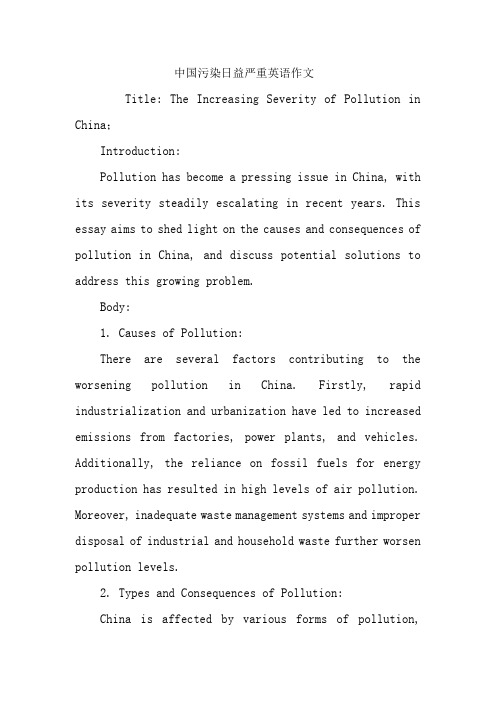
中国污染日益严重英语作文Title: The Increasing Severity of Pollution in China;Introduction:Pollution has become a pressing issue in China, with its severity steadily escalating in recent years. This essay aims to shed light on the causes and consequences of pollution in China, and discuss potential solutions to address this growing problem.Body:1. Causes of Pollution:There are several factors contributing to the worsening pollution in China. Firstly, rapid industrialization and urbanization have led to increased emissions from factories, power plants, and vehicles. Additionally, the reliance on fossil fuels for energy production has resulted in high levels of air pollution. Moreover, inadequate waste management systems and improper disposal of industrial and household waste further worsen pollution levels.2. Types and Consequences of Pollution:China is affected by various forms of pollution,including air pollution, water pollution, and soil contamination. Air pollution, primarily caused by industrial emissions and vehicle exhaust, leads to respiratory problems and other health issues. Water pollution, mainly caused by industrial discharge and agricultural runoff, poses a threat to aquatic ecosystems and human health. Soil contamination due to improper waste disposal and excessive use of pesticides affects agricultural productivity and food safety.3. Environmental and Health Impacts:The impacts of pollution in China are far-reaching. Degraded air quality not only affects public health but also hampers visibility and contributes to global climate change. Water pollution disrupts ecosystems, threatens biodiversity, and limits the availability of safe drinking water. Soil contamination reduces soil fertility, affects crop yields, and can result in the accumulation of toxins in food chains, posing health risks to humans and animals.4. Proposed Solutions:Addressing pollution requires comprehensive and coordinated efforts from the government, industries, and individuals. Some potential solutions include:a) Implementing stricter environmental regulations and enforcing them effectively.b) Encouraging the adoption of cleaner and more sustainable technologies in industries.c) Promoting renewable energy sources to reduce reliance on fossil fuels.d) Enhancing waste management systems and promoting recycling and proper disposal practices.e) Raising public awareness about the importance of environmental protection and encouraging individual actions to reduce pollution.Conclusion:The escalating pollution in China is a significant concern with wide-ranging consequences for both the environment and human health. It is crucial for all stakeholders to come together and take immediate actions to combat pollution. By implementing effective measures and fostering a collective sense of responsibility, we can strive towards a cleaner and healthier environment for present and future generations in China.。
中国的污染日益严重英语作文

中国的污染日益严重英语作文【中英文实用版】The increasing pollution in China has become a pressing issue that cannot be overlooked.The once picturesque landscapes are now shrouded in a haze of industrial emissions, causing a detrimental impact on both the environment and public health.It is high time that we addressed this burgeoning problem with immediate and effective measures.中国的污染问题日益严重,已经到了不容忽视的地步。
曾经如诗如画的景色,如今被工业排放的阴霾所笼罩,对环境和公众健康造成了严重的影响。
是时候采取及时有效的措施来解决这个日益加剧的问题了。
Air pollution, particularly, has reached alarming levels, with smoggy days becoming a regular occurrence in many cities.The toxic blend of fine particulate matter and有害gases poses a significant threat to the respiratory health of millions.It is no longer just an environmental issue; it has become a public health crisis.空气污染尤为严重,许多城市雾霾天气已成为常态。
细颗粒物和有害气体的混合物对数百万人的呼吸健康构成了严重威胁。
中国环境污染的影响英语作文
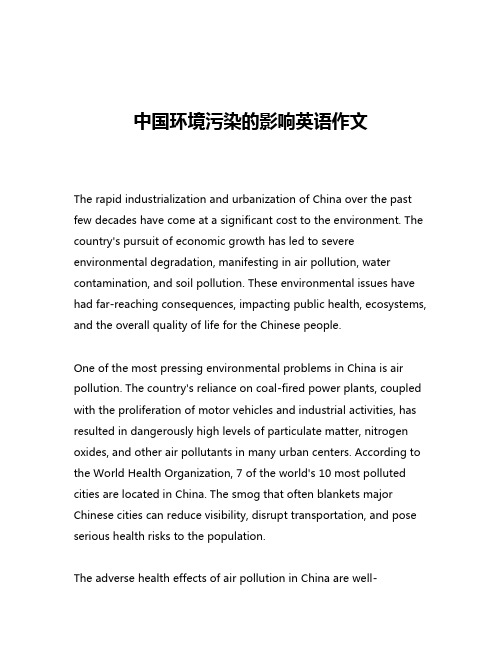
中国环境污染的影响英语作文The rapid industrialization and urbanization of China over the past few decades have come at a significant cost to the environment. The country's pursuit of economic growth has led to severe environmental degradation, manifesting in air pollution, water contamination, and soil pollution. These environmental issues have had far-reaching consequences, impacting public health, ecosystems, and the overall quality of life for the Chinese people.One of the most pressing environmental problems in China is air pollution. The country's reliance on coal-fired power plants, coupled with the proliferation of motor vehicles and industrial activities, has resulted in dangerously high levels of particulate matter, nitrogen oxides, and other air pollutants in many urban centers. According to the World Health Organization, 7 of the world's 10 most polluted cities are located in China. The smog that often blankets major Chinese cities can reduce visibility, disrupt transportation, and pose serious health risks to the population.The adverse health effects of air pollution in China are well-documented. Exposure to fine particulate matter (PM2.5) has been linked to an increased risk of respiratory diseases, cardiovascular problems, and lung cancer. A study published in the Lancet Planetary Health journal estimated that air pollution contributed to the premature deaths of over 1.1 million people in China in 2017 alone. Children and the elderly are particularly vulnerable to the harmful effects of air pollution, which can impair lung development and exacerbate existing medical conditions.In addition to the human toll, air pollution also takes a significant economic toll on China. The costs associated with healthcare, lost productivity, and environmental degradation are estimated to be in the billions of dollars annually. The Chinese government has implemented various measures to address the air pollution crisis, such as transitioning to cleaner energy sources, implementing vehicle emission standards, and closing down heavily polluting factories. However, the scale of the problem remains daunting, and more comprehensive and sustained efforts are needed to achieve meaningful improvements in air quality.Another major environmental concern in China is the contamination of water resources. Industrial waste, agricultural runoff, and untreated sewage have all contributed to the pollution of rivers, lakes, and groundwater. According to a government survey, nearly 70% of China's major lakes and rivers are considered unsuitable forhuman contact due to high levels of pollution. This has had devastating consequences for aquatic ecosystems, as well as the communities that rely on these water sources for drinking, irrigation, and other essential uses.The impact of water pollution on public health in China cannot be overstated. Exposure to contaminated water can lead to a range of waterborne diseases, such as cholera, typhoid, and hepatitis. In some rural areas, the lack of access to clean drinking water has been linked to increased rates of cancer and other chronic illnesses. The government has made efforts to improve wastewater treatment and enforce stricter regulations on industrial discharges, but the scale of the problem remains overwhelming.Soil pollution is another significant environmental challenge facing China. The country's rapid industrialization and the widespread use of pesticides and fertilizers in agriculture have led to the contamination of vast tracts of land. A national survey conducted in 2014 found that nearly 20% of China's arable land was polluted to varying degrees, rendering it unsuitable for food production. The presence of heavy metals, organic pollutants, and other contaminants in the soil can pose serious risks to human health, as these substances can accumulate in the food chain and ultimately be consumed by people.The consequences of soil pollution in China are far-reaching. It not only threatens food security but also undermines the livelihoods of farmers and rural communities. Contaminated soil can also lead to the degradation of ecosystems, as pollutants can leach into groundwater and impact the health of plants and wildlife. The Chinese government has implemented various remediation efforts, such as the establishment of soil pollution control and prevention plans, but the scale of the problem remains daunting.The environmental challenges facing China are not limited to the immediate impacts on public health and ecosystems. The long-term implications of environmental degradation in the country are also significant. Climate change, for instance, is exacerbated by China's heavy reliance on fossil fuels, and the country is already experiencing the effects of rising temperatures, sea levels, and extreme weather events. These climate-related impacts are likely to have cascading effects on agriculture, water resources, and the overall well-being of the Chinese population.Moreover, the environmental problems in China have global implications. As the world's second-largest economy and a major contributor to greenhouse gas emissions, the country's environmental policies and practices have far-reaching consequences for the global community. The transboundary nature of air and water pollution means that the environmental issues in China can alsoimpact neighboring countries and the broader international community.In response to these pressing environmental challenges, the Chinese government has implemented a range of policies and initiatives aimed at addressing the country's environmental problems. These efforts have included the implementation of stricter environmental regulations, the promotion of renewable energy sources, the development of eco-cities, and the enforcement of pollution control measures. Additionally, the government has invested heavily in environmental research and development, with the goal of developing innovative solutions to the country's environmental challenges.However, despite these efforts, the scale and complexity of China's environmental problems remain daunting. Achieving meaningful and sustainable improvements will require a multifaceted approach that involves not only government action but also the active participation of businesses, civil society, and the general public. Addressing the root causes of environmental degradation, such as the reliance on fossil fuels and the unsustainable use of natural resources, will be crucial in ensuring a more environmentally-resilient future for China and the global community.In conclusion, the environmental pollution in China has had far-reaching consequences for the country's public health, ecosystems, and overall quality of life. The problems of air pollution, water contamination, and soil degradation have posed significant challenges to the Chinese government and the broader population. Addressing these environmental challenges will require a comprehensive and sustained effort, involving a range of stakeholders and a commitment to sustainable development. As China continues to grapple with these issues, the country's environmental policies and practices will have a profound impact on the global community, underscoring the need for international cooperation and collective action in addressing the pressing environmental concerns of our time.。
AirpollutioninChina中国空气污染英文

The Air Pollution in China AbstractChina is now faced with serious air pollution, such as PM2.5, NO x and SO2. It’s time to take effective and strict measures on pollution control. People should heighten the environmental awareness and take simple steps in normal. Meantime, government have to formulate relevant laws and regulations to create a harmonious society.Keywords: China, air pollution, regulations.1 Status of Air Pollution in ChinaAir quality has bee a big topic in recent years. Tens of millions of people across China have been forced to cope with high levels of PM2.5 -- particulate matter smaller than 2.5 micrometers in diameter that can penetrate the lungs and harm the respiratory, cardiovascular, cerebral vascular and nervous systems. Air pollution is not just about sore throats, but really more of a matter of life or death. The harmful effects that smog can have on the human body are one of the top concerns among those who reside in the country’s bigger cities.Due to the coal dominating energy structure, the urban atmospheric environment in China has been seriously polluted by high concentrations of NO x and SO2since many years ago. With the rapid development of economy, urbanization and transportation in the past two decades, vehicle exhaust pollution also aggravated. Within the last two decades, all types of environmental problems, which were experienced for nearly a century in developed countries, exploded in the developed regions in China. Regional air pollution plex, bined with coal-bustion pollution andvehicle-exhaust pollution has emerged in key city clusters of China, which was characterized as a plex of local and regional pollution and multi-pollutants. Regional air quality has a trend of exacerbation with the frequent occurance of photochemical smog, regional haze and acid deposition, and the health risks from toxic and harmful air pollutants.In some sense, traffic jam is one of the most severe problems disturbing traffic in Beijing for a long time and retards the development of economy. So congested a city as it is, Beijing has gotten a quality report on city life with ten ranking decreasing this year. The traffic topes among the entire factors.This is indeed the case. The problem has been brought to the close notice of local authorities, especially more and more traffic research institutes. Though they have a mitment to traffic jam study, the consequences are anything but satisfactory. At the mention of traffic, Wang Qishan, mayor of Beijing, has expressed his disappointment several times about congested situation in the public. Traffic in Beijing is facing a challenge again while Olympic 2008 is ing. On the other hand, opportunity is equal to challenge if we go out of our way to discover the rub. There are some consensual opinions below.First of all, unreasonable city planning is the primary reason, not the number of motor vehicle in nature, for Tokyo has an unchecked traffic flow with the motor quantity of 7200,000, and Beijing has usual traffic jam with only 2000,000 instead. Nowadays, it is the circle roads that support more than half of traffic density, which makes its rush hour traffic intolerable.Secondly, pared with some big cities in the world, the quantity of taxies in Beijing is larger than any of them. Taxies occupy 30% to 40% road area, 37% to 50% ones empty.Thirdly, high – density shopping center leads district jam. In weekend, especially in seven –day holidays like the National Day, most of citizens go out only for sports,and then vehicles rush to shopping center and entertainment district, then the traffic there is beyond wildest guess.In a word, effective measures are needed for traffic nowadays. Public methods, just like subway and bus, are one of the good ways against traffic jam. Intelligent transportation system study is pushed forward also. Another way, timely traffic control is feasible. While China-Africa summit was held, these measures were effective to a certain degree.2 Emissions of Major Air Pollutants in the CountryCoal accounts for 70 percent of Chi na’s energy consumption. This fact is hard to change in a short term. In terms of the coal use method, 80 percent of the coal was for direct bustion. Among others, coal-fired power plants burn 50 percent of the total coal in China. Coal burning is the major source of ambient SO2, NO x, and soot.China’s coal consumption experienced an increase by more than 800 million tons, over 500 million tons of which went to thermal power industry. The findings of relevant studies have shown that about 20,000 yuan of economic losses occurred with every ton of SO2emission, and air pollution, especially acid rain has significantly constrained the efforts in achieving the goal of building a Xiaokang Society in an all-round way.Motor vehicles, industrial production, coal and dust are the main sources of particulate matter pollution in most Chinese cities, accounts from 85% to 90%. Motor vehicles are primary pollution source in Beijing, Hangzhou, Guangzhou, Shenzhen. While in Shijiazhuang, Nanjing, Tianjin, Shanghai and Ningbo, the primary pollution source were dust, current source, industrial production Respectively.At present, our country has the grim situation of air pollution, the environment problems characterized by regional atmospheric pollutants such as particulate matter (PM10) and fine particulate matter (PM2.5) increase prominently, do great harm to people's health and affect social harmony and stability.3 How can we control air pollution in the environment?Air pollution has bee a serious problem in recent years. There are a lot of causes. First of all, is the chemical noxious gases emission. We all know that there are a lot of factories around the world, they are actually emitting such gases everyday. The second one is the sharp decrease of the forests. Forest is very important to our Eco-system, it can adjust the heat and balance the air. The third one is the urbanization. People tend to stay in the city where is actually an abnormal Eco-system. Many cities do not have a plete system of controlling the air pollution.In order to solve such problems, there are some simple ways to control air pollution in our daily life.(1)Drive less, ride bicycle or walk instead.(2)Replace all the lightbulbs in and around your home with energy-efficientfluorescents that use fewer watts for the same amount of light.(3)Choose energy-efficient appliances when it's time to buy new ones.(4)Decrease your air travel.(5)Wash clothes in cold water and line-dry whenever possible.(6)Use a low-flow showerhead, which will lessen the hot water used but not dropyour water pressure in the shower.(7)Cut down on your garbage buy fewer packaged materials(8)Unplug electronics when they are not in use, because they still take up energy.(9)Insulate your home better(10)B uy recycled paper products and recycle as much of your waste as possible.(11)P lant a tree.(12)U se nontoxic cleaning products.4 No Place to HideHowever, like you could see when examining crime statistics, it's not the polluters you can see that are the problem. It's the ones that have drawn a veil, and worked in places where governments will let them have a free hand, who cause the most damage.China has, in the last thirty years, doubled in the total amount of land area that qualifies as a desert.She has also lost a substantial amount of the forest cover on her land. This environmental change is causing people from the rural northwest part of China to seek new lives along the river network in the heart of the country, along the China air pollution central region, the new Industrial Corridor.Unfortunately, the Industrial Corridor, most of which has factories built, or purchased from overseas and transported inland, is one of the major garbage pollution belts in China. Wastewater outlets are causing fish to die off and raising the incidences of liver, stomach and jaw cancers in people living in the villages near the factories to skyrocket.China's extensive effort to make rapid modernizations and create industrialization has resulted in the need and means for the Three Gorges Dam, which provides hydroelectric power for much of Northern China. It's also displaced tens of millions of people who used to live, fish and farm along the Yangtze River, and caused more of the China air pollution and urban problems to expand.While China is the manufactory of the world, it's also the largest consumer of illegally harvested timber. China's rapid pace of industrialization in the early 21st century meant that a new coal fired plant opened up roughly ever two weeks duringthis period in China. Furthermore, China's coal mining operations are causing underground fires that spit out tonnes of CO2, carbon dioxide, every day.5 China Environmental RegulationsChina does not regulate environmental issues the way the Western world does; in a very real sense, China is trying to catch up with the West industrially, without paying the surcharge that environmental sustainability will impose.This attitude created the Ten Year Boom, which culminated in increasing Beijing pollution and the 2008 Olympics, but also created an acid rain problem that impacts Korea and Japan while the soot and dust clouds of China air pollution sometimes reach the western United States and Canada.There is cause for hope. The same economic collapse that's driving down American and Western European consumption has caused a disproportionate ripple effect in the Chinese economy, which is driven largely by exports. Because the costs of Chinese environmental degradation was offset by the growth in GDP from the Ten Year Boom, it was easy to overlook the issue. Now that there isn't a booming economy like before, the costs of China air pollution are ing home and being all too real.The government of China has put out a 600 billion dollar program to boost sustainability and environmental regulations, including strong incentives to build more nuclear power plants, which are far less polluting. The incentives also improve waste water treatment, and rubbish disposal. Hopefully they will also boost the cleanliness of the transportation sector, by increasing the use of electric or pressed air cars. Everything China does on an environmental scale will be a large scale experiment. The oute is still surrounded by some doubt. But there is hope.In the whole month of January, only five days were not covered by heavy smog in Beijing. The city is now seeing an increasing amount of face masks on the streets and sales for air purifiers have also shot up as a result of recent ongoing pollution. The smog has made residents more conscious about potential health risks. Many have taken steps to reduce the impact of the city's toxic air as much as they can. Li Dong has the details.PM2.5 is one of the major pollutants of the air pollution in Beijing and it poses the greatest risk to human health. Its concentration reached a record high of 993 on January 12, almost 50 times the World Health Organization's remended level. PM2.5 levels across most of Beijing have been above 400 micrograms per cubic meter for much of the last two weeks.When the air is this hazardous, the government remends people avoid outdoor activities. But many must still go outside causing a sharp increase in the use of face masks. Lulu is a Beijing resident. "I felt the smog was really thick yesterday, it hurts my throat and hurts to breathe. So I started to wear a mask today. The air pollution is really serious." Face mask sales are going through the roof both online and in-store. The most popular face mask retailer on Taobao, China's leading online shopping website, has sold more than 112,000 masks in the past month.Tong Ren Tang, a large pharmacy, has also seen a dramatic increase in mask sales in recent weeks. A sales clerk says: "The pollution has been very severe the past weeks. There has been a sharp increase in face mask sales in recent weeks pared with the same period last year. "The ongoing air pollution is raising health concerns among Beijing residents. Many are choosing to travel out of the city to avoid the thick smog, while others are purchasing air purifiers to filter indoor air. Officials have closed some factories and ordered some government cars off the road to reduce emissions. They have also proposed rules to scrap old vehicles and to ban new cement and steel factories.TOTO Beijing is the only big ceramics factory in the capital city. One of its production procedures creates dust pollution. With air pollution escalating in the lastseveral days, the city government told the factory to cut production. Han Yong, deputy general manager of TOTO Beijing says halting production means big losses for the factory. "Stopping our two plants in Beijing means we lose 1 million yuan or about 160,000 US dollars per day at the eastern factory and 0.8 million yuan at the western factory. "TOTO Beijing is only one of a 103 high-polluting factories that have pletely stopped production since Tuesday. Authorities say they were cutting the use of government vehicles by all departments by 30 percent.However, once the smog gets lighter and the alert is lifted, factories will be back in production again. They may need to intensify production to make up for their losses, so the problem has not really been solved. Many believe that the government will have to do more to cut the pollution sources, because temporary responses are not enough.As everyone who's ever visited or lived in China knows, in recent years the air pollution problem has bee enormous. When you fly in to China it's often in to an insipid pall of pollution, especially if you are flying in to Beijing, Shanghai or Guangzhou. The yellowish cloud of toxicity that overlies many Chinese cities is legendary.The air pollution is a bination of things, industrial burning and cooling etc as well as vehicles and other sources, with industry being the major polluter. The problem is not just limited to the air, groundwater and soil pollution is now so bad in China that the PRC central government refused to release it's last survey results. This maybe due to the fact that they don't want to panic the population or scare of investment.What can be done about it? Well a lot can be done, firstly China should enforce and reinforce it's own pollution laws and then ensure the standards are up to the same as in the first world. Massive fines for serial polluters helps, I'd suggest fines of 10-20% of gross revenue for a year if a business fails to meet the emissions standards. To bat corruption automatic metering systems should be fitted to all smoke stacks and generators and results checked by at least 5 offices around China with the officesreceiving the data at random. No factory identification other than a number should be given to the office. This would eliminate bribery of pollution monitoring officers. panies whose meters are inoperable should be fined 10% of gross annual turnover for each day the meters are inoperable. A massive carrot and stick is required to ensure adherence to the law. The same basic concept can be used to help bat water pollution.Recycling probably needs to be better organized. Financial bonuses in the form of tax breaks for panies that use green packaging and or recycle waste would help.China could also look at imitating best global practices from around the world. The use of LED lighting for example as well as energy management schemes and anti-pollution techniques developed in the west are only going to help China in the long term.。
中国的污染日益严重英语作文
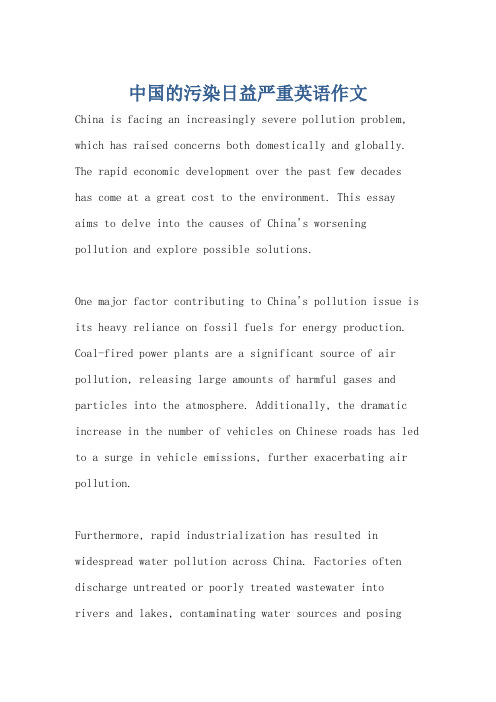
中国的污染日益严重英语作文China is facing an increasingly severe pollution problem, which has raised concerns both domestically and globally. The rapid economic development over the past few decades has come at a great cost to the environment. This essay aims to delve into the causes of China's worseningpollution and explore possible solutions.One major factor contributing to China's pollution issue is its heavy reliance on fossil fuels for energy production. Coal-fired power plants are a significant source of air pollution, releasing large amounts of harmful gases and particles into the atmosphere. Additionally, the dramatic increase in the number of vehicles on Chinese roads has led to a surge in vehicle emissions, further exacerbating air pollution.Furthermore, rapid industrialization has resulted in widespread water pollution across China. Factories often discharge untreated or poorly treated wastewater intorivers and lakes, contaminating water sources and posingserious health risks for both humans and wildlife. Agricultural activities have also contributed to water pollution through excessive use of pesticides and chemical fertilizers that find their way into water bodies.Another important aspect contributing to China's pollution problem stems from inadequate environmental regulations and lax enforcement. While there are regulations in place,their implementation and enforcement have been inconsistent throughout different regions of the country. As a result, many companies continue to operate without proper measures in place to control their emissions or waste disposal practices.Moreover, population growth plays a significant role in exacerbating pollution levels in China. With a population of over 1.4 billion people, demands for energy, transportation, and consumer goods have skyrocketed. This increased consumption intensifies pressure on natural resources and generates more waste that needs to be disposed of properly.In order to tackle this escalating problem, several measures can be taken at both individual and governmental levels. Firstly, promoting clean energy sources such as solar and wind power can help reduce reliance on coal-fired power plants. Encouraging environmentally-friendly transportation alternatives like electric cars or public transportation systems can also significantly mitigate air pollution caused by vehicle emissions.Furthermore, stricter enforcement of environmental regulations is crucial. Government agencies should implement effective monitoring systems and impose hefty fines on companies that violate pollution control measures. This will create a deterrent effect and encourage companies to prioritize environmental sustainability.Education and awareness campaigns can also play a vitalrole in reducing pollution. By educating the public about the importance of responsible consumption, recycling, and proper waste disposal, individuals can actively contribute to minimizing pollution levels in their daily lives.In conclusion, China's pollution problem has reached alarming levels due to its heavy reliance on fossil fuels, rapid industrialization, inadequate regulations, and population growth. However, by shifting towards cleaner energy sources, tightening enforcement of environmental regulations, and promoting education and awareness among the public, steps can be taken to address this pressing issue. It is everyone's responsibility to take action in order to safeguard the environment for future generations.。
the environment problem 中国环境问题

the environment problemAs we all know, China is a country has nearly 20% population of the world. The huge number of population has caused many serious problem such as the pollution of environment. One of the main contamination is the exhaust emission from the vehicles.As more and more people have their trip by vehicles everyday, the pollution has got worse and worse. Thus, the air quality has deteriorated badly these past few years. Many underlying diseases such as respiratory infections, heart disease, and lung cancer are triggered quite easily by the air pollution. There is no denying the fact that air pollution is an extremely serious problem: that we should take strong measures to deal with it.First of all, the government should carry out direct and purposeful policy targeted to the air pollution caused by vehicles. And we already have one ——Chinese government has set vehicular quotas and restricted the number of private cars in big cities in order to control the regional air pollution. I think this policy is practicable because it can effectively reduce the exhaust emission from private cars, and it also shows us that the authority do focus on this problem and is trying hard to solve it properly.Secondly, we citizens should also do what we can to avoid the air pollution. For example, we should appeal everyone to use their private cars as less frequently as possible aims to raise the awareness of environmental problems caused by the heavy usage of cars in urban areas and also make people reconsider the way they travel. Without vehicles, people can think of some new ways for transportation that can be seen as a cleaner and more sustainable mode of transport. “ofo" is a good example, I think.All in all, everyone should take their part in protecting our environment from too much contaminated air and make our surroundings more favorable.。
中美环境污染对比英语作文
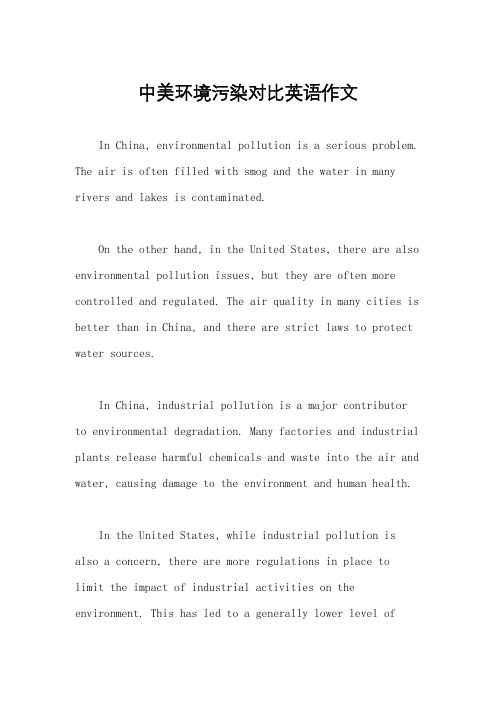
中美环境污染对比英语作文In China, environmental pollution is a serious problem. The air is often filled with smog and the water in many rivers and lakes is contaminated.On the other hand, in the United States, there are also environmental pollution issues, but they are often more controlled and regulated. The air quality in many cities is better than in China, and there are strict laws to protect water sources.In China, industrial pollution is a major contributor to environmental degradation. Many factories and industrial plants release harmful chemicals and waste into the air and water, causing damage to the environment and human health.In the United States, while industrial pollution is also a concern, there are more regulations in place tolimit the impact of industrial activities on the environment. This has led to a generally lower level ofenvironmental pollution compared to China.One of the biggest challenges in China is the rapidpace of urbanization and industrialization, which has ledto increased pollution levels. The country is struggling to balance economic growth with environmental protection.In the United States, there is a greater emphasis on sustainable development and green technologies, which has helped to reduce the impact of pollution on the environment.Overall, while both China and the United States face environmental pollution issues, the level and severity of pollution in China is generally higher, and the country faces greater challenges in addressing these problems.。
中国污染严重英文作文
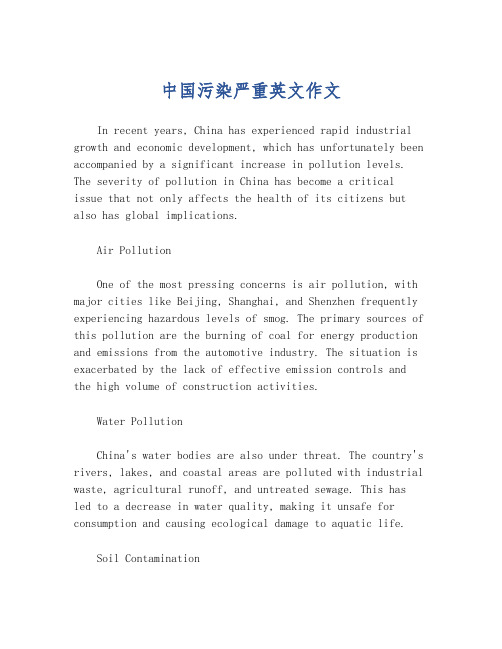
中国污染严重英文作文In recent years, China has experienced rapid industrial growth and economic development, which has unfortunately been accompanied by a significant increase in pollution levels. The severity of pollution in China has become a critical issue that not only affects the health of its citizens but also has global implications.Air PollutionOne of the most pressing concerns is air pollution, with major cities like Beijing, Shanghai, and Shenzhen frequently experiencing hazardous levels of smog. The primary sources of this pollution are the burning of coal for energy production and emissions from the automotive industry. The situation is exacerbated by the lack of effective emission controls and the high volume of construction activities.Water PollutionChina's water bodies are also under threat. The country's rivers, lakes, and coastal areas are polluted with industrial waste, agricultural runoff, and untreated sewage. This has led to a decrease in water quality, making it unsafe for consumption and causing ecological damage to aquatic life.Soil ContaminationSoil pollution is another area of concern, with heavy metals and toxic chemicals from industrial processes accumulating in the soil. This not only affects the fertility of the land but also poses a risk to the food supply, as these contaminants can enter the food chain.Health and Economic ImpactsThe health impacts of pollution are substantial. Respiratory illnesses, cardiovascular diseases, and certain types of cancer have been linked to long-term exposure to polluted air. The economic impact is also significant, with increased healthcare costs and reduced productivity due to illness.Government Efforts and Public AwarenessThe Chinese government has recognized the severity of the pollution problem and has initiated various measures to combat it. These include setting new standards for air and water quality, investing in renewable energy sources, and enforcing stricter regulations on industrial emissions. Public awareness campaigns have also been launched to educate citizens about the importance of environmental protection and sustainable practices.ConclusionWhile the situation is dire, there is a growing commitment to change. The fight against pollution in China is a complex and long-term battle that requires the cooperationof the government, industry, and the public. It is a challenge that must be met to ensure the health and well-being of the Chinese people and to preserve the environment for future generations.。
中国空气污染英语作文
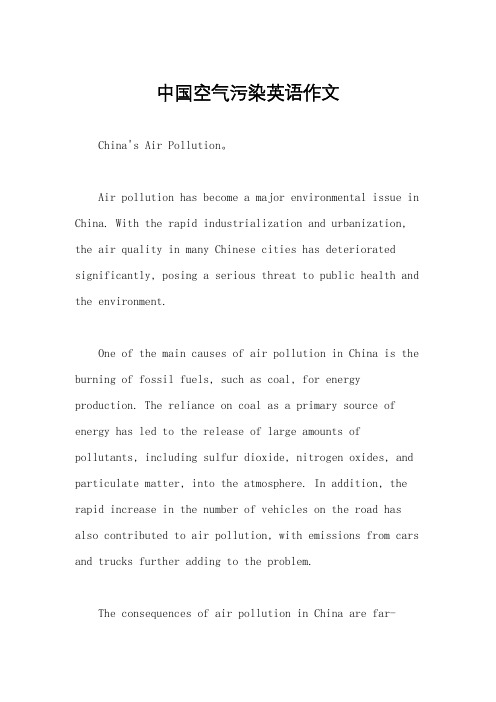
中国空气污染英语作文China's Air Pollution。
Air pollution has become a major environmental issue in China. With the rapid industrialization and urbanization, the air quality in many Chinese cities has deteriorated significantly, posing a serious threat to public health and the environment.One of the main causes of air pollution in China is the burning of fossil fuels, such as coal, for energy production. The reliance on coal as a primary source of energy has led to the release of large amounts of pollutants, including sulfur dioxide, nitrogen oxides, and particulate matter, into the atmosphere. In addition, the rapid increase in the number of vehicles on the road has also contributed to air pollution, with emissions from cars and trucks further adding to the problem.The consequences of air pollution in China are far-reaching. High levels of air pollution have been linked toa range of health problems, including respiratory diseases, cardiovascular diseases, and even premature death. In addition, air pollution also has a significant impact onthe environment, leading to acid rain, damage to ecosystems, and the depletion of the ozone layer.In recent years, the Chinese government has taken steps to address the issue of air pollution. In 2013, the government announced a comprehensive action plan to tackle air pollution, which included measures to reduce coal consumption, improve fuel quality, and promote the use of clean energy sources. In addition, the government has also implemented stricter emission standards for vehicles and industrial facilities, as well as introduced measures to control the burning of agricultural waste.Despite these efforts, air pollution continues to be a major problem in China. In many cities, air quality levels often exceed the World Health Organization's guidelines,with smog and haze frequently shrouding the skyline. This has led to growing public concern about the health impactsof air pollution, as well as calls for more aggressive action to tackle the problem.In conclusion, air pollution is a significant challenge for China, with serious implications for public health and the environment. While the government has taken steps to address the issue, more needs to be done to reduce emissions and improve air quality. It is essential for all sectors of society to work together to find sustainable solutions to this pressing problem. Only by taking decisive action can China hope to create a cleaner and healthier environment for its citizens.。
中国污染现状英语作文
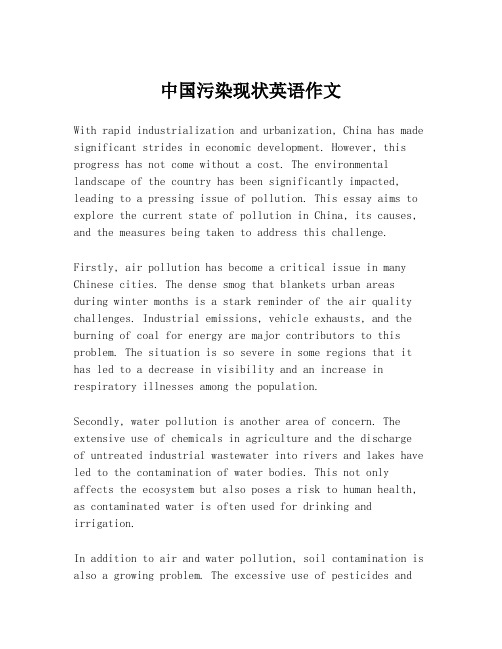
中国污染现状英语作文With rapid industrialization and urbanization, China has made significant strides in economic development. However, this progress has not come without a cost. The environmental landscape of the country has been significantly impacted, leading to a pressing issue of pollution. This essay aims to explore the current state of pollution in China, its causes, and the measures being taken to address this challenge.Firstly, air pollution has become a critical issue in many Chinese cities. The dense smog that blankets urban areas during winter months is a stark reminder of the air quality challenges. Industrial emissions, vehicle exhausts, and the burning of coal for energy are major contributors to this problem. The situation is so severe in some regions that it has led to a decrease in visibility and an increase in respiratory illnesses among the population.Secondly, water pollution is another area of concern. The extensive use of chemicals in agriculture and the discharge of untreated industrial wastewater into rivers and lakes have led to the contamination of water bodies. This not only affects the ecosystem but also poses a risk to human health, as contaminated water is often used for drinking and irrigation.In addition to air and water pollution, soil contamination is also a growing problem. The excessive use of pesticides andfertilizers has led to a decline in soil quality, affecting the productivity of agricultural lands and the safety of the food supply.The Chinese government has recognized these issues and has initiated a series of measures to combat pollution. Policies such as the "Action Plan for Air Pollution Prevention and Control" and the "Water Pollution Prevention and Control Action Plan" have been implemented. These plans include stricter regulations on emissions, incentives for clean energy, and investments in public transportation to reduce reliance on private vehicles.Furthermore, there is a push towards sustainable development, with a focus on green technologies and renewable energy sources. The promotion of electric vehicles and the expansion of public transportation networks are examples of steps being taken to reduce the carbon footprint.Public awareness campaigns are also being conducted to educate citizens about the importance of environmental protection and the role they can play in reducing pollution. Encouraging recycling, reducing waste, and supporting eco-friendly products are some of the ways individuals are being empowered to contribute to the solution.In conclusion, while the current state of pollution in China is a cause for concern, it is encouraging to see the government and its citizens taking proactive steps to address this environmental crisis. Through a combination of policy changes, technological advancements, and public engagement,there is hope for a cleaner and more sustainable future for China.。
我国的环境污染英语作文
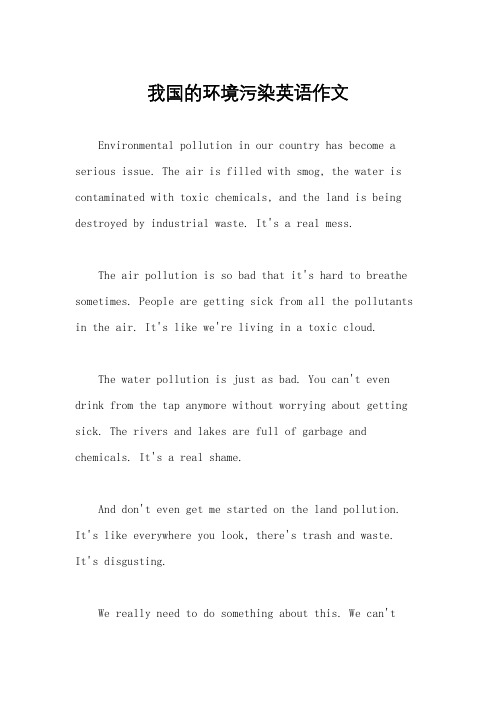
我国的环境污染英语作文Environmental pollution in our country has become a serious issue. The air is filled with smog, the water is contaminated with toxic chemicals, and the land is being destroyed by industrial waste. It's a real mess.The air pollution is so bad that it's hard to breathe sometimes. People are getting sick from all the pollutants in the air. It's like we're living in a toxic cloud.The water pollution is just as bad. You can't even drink from the tap anymore without worrying about getting sick. The rivers and lakes are full of garbage and chemicals. It's a real shame.And don't even get me started on the land pollution. It's like everywhere you look, there's trash and waste.It's disgusting.We really need to do something about this. We can'tkeep destroying our environment like this. We need to start taking better care of the earth before it's too late.I hope the government will start taking this issue seriously and come up with some solutions. We can't keep ignoring the problem. We need to take action now.。
【最新】中国的污染英语作文-范文word版 (1页)
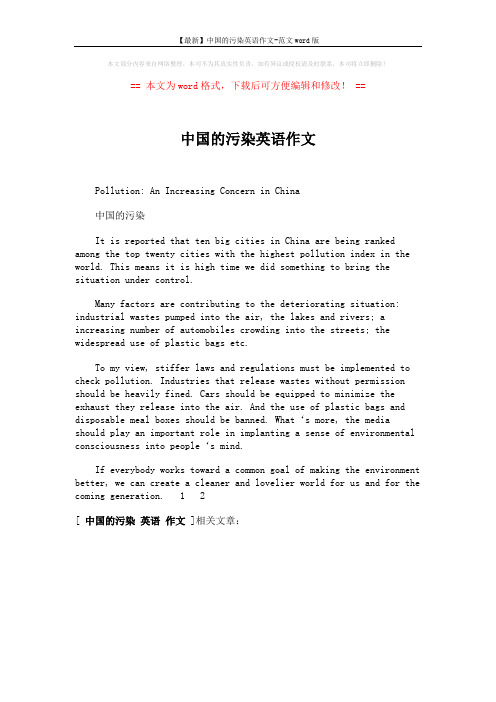
【最新】中国的污染英语作文-范文word版本文部分内容来自网络整理,本司不为其真实性负责,如有异议或侵权请及时联系,本司将立即删除!== 本文为word格式,下载后可方便编辑和修改! ==中国的污染英语作文Pollution: An Increasing Concern in China中国的污染It is reported that ten big cities in China are being ranked among the top twenty cities with the highest pollution index in the world. This means it is high time we did something to bring the situation under control.Many factors are contributing to the deteriorating situation: industrial wastes pumped into the air, the lakes and rivers; a increasing number of automobiles crowding into the streets; the widespread use of plastic bags etc.To my view, stiffer laws and regulations must be implemented to check pollution. Industries that release wastes without permission should be heavily fined. Cars should be equipped to minimize the exhaust they release into the air. And the use of plastic bags and disposable meal boxes should be banned. What‘s more, the media should play an important role in implanting a sense of environmental consciousness into people‘s mind.If everybody works toward a common goal of making the environment better, we can create a cleaner and lovelier world for us and for the coming generation. 1 2[ 中国的污染英语作文]相关文章:。
- 1、下载文档前请自行甄别文档内容的完整性,平台不提供额外的编辑、内容补充、找答案等附加服务。
- 2、"仅部分预览"的文档,不可在线预览部分如存在完整性等问题,可反馈申请退款(可完整预览的文档不适用该条件!)。
- 3、如文档侵犯您的权益,请联系客服反馈,我们会尽快为您处理(人工客服工作时间:9:00-18:30)。
Health impacts from pollution
• Pollution is killing hundreds of thousands of Chinese people every year. • The pollution is causing people to wear mask’s, and to get very ill. • In Australia people live much longer there the Chinese people because the Australians care about their health and their environment.
China's . pollution
5 interesting facts.
• • • • • The smog is killing many people . China has the biggest population in the world. China invented the cross bow. There are heaps of heritage places in China China is a very religious place.
China’s a beautiful place
• People may not like China because of all the smog but behind all that smog there are some lovely places in China , like • MT Taishan. • MT Taishan is a significant place to the Chinese because a few hundred years a go every emperor use to pray that this BEAUTIFUL place.
How China is trying to reduce the pollution
China is making more improvements over the years. China is trying to increase the forest cover, and reduce the pollution. The pollution is getting better but China is still working on it to make it even better.
China’s environment
What is causing pollution?
• In China smog is becoming a major problem. The Chinese people are cutting down rain forest to build factory’s and houses. • In China it is unbelievable how much electricity is getting wasted, China’s smog is getting worse every single year.
